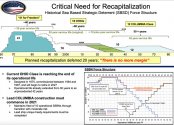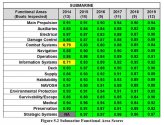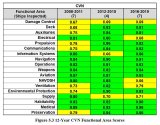It might be the Sixth gen fighter we've been hearing about.
You are using an out of date browser. It may not display this or other websites correctly.
You should upgrade or use an alternative browser.
You should upgrade or use an alternative browser.
US Military News, Reports, Data, etc.
- Thread starter tphuang
- Start date
I brought it up in the FA-XX/F-X thread for the 6th gen US already.It might be the Sixth gen fighter we've been hearing about.
Rolls Royce has been chosen to provide roughly 600 engines for the B-52 re-engine program.
Rolls Royce has been chosen to provide roughly 600 engines for the B-52 re-engine program.
Looks like it will solve the smoky engine problem.
TerraN_EmpirE
Tyrant King
Biggest thing it would help solve is the engine cost problem. The TF33 is a relic yet is the heart of 3 mission critical aircraft. B52, E3 and the C135 series. It’s age and reliability issues are at the heart of readiness issues for the platforms that fly on it. If the USAF follows re-engining the B52 with potential E7 buy and can get Boeing to get the KC46 issues ironed out that will shift the TF33 out of service and be a boon to readiness and maintenance
Kinda looks like the dress uniform from the Star Trek series.
Was going to say the same thing.
From:
The article stages a traditional narrative for rationalizing expenditures but some interesting information can be found between the lines, especially in the context of the ongoing debate on Capitol Hill about the sustainability and capability of current industrial base.
"The Navy bought its first SSBN in fiscal 2021, will buy the second in FY24 and will buy the remaining 10 at a one-a-year pace from FY26 through FY35."
"The Ohio-class has already gone through life-extension work to bring the hulls to 42 years of operations, but last fall, program officials revealed they may look at each hull to see which are likely to be able to serve for a couple extra years, as a buffer to any future delays the Columbia program may face."
"Navy is doing feasibility studies now, laying out what would have to happen to each boat if the service were to decide to extend their lives. He made clear it’s not the official engineering assessment, which would be the final determination on whether the sub can safely continue operating longer than planned, but based on this early work, Stefany said at least a couple SSBNs could be extended if Columbia one-a-year construction proves to be too much of a challenge."
Already with Ohio extension the planned delivery of Columbias will cause a drop in SSBN force to minimum of 10 ships allowed by STRATCOM in the entire period of 2030-2040. If Columbia program encounters any delay the service of some Ohios will have to be further extended just to maintain that minimum capacity.
From the article - illustration of Sea Based Strategic Deterrent timeline:

Furthermore the program already consumes majority of additional funding for new construction:
"The new PEO SSBN will include a Columbia program office, an in-service SSBN and SSGN support office, and a submarine industrial base program office. The Navy previously had a complex arrangement among PEO Columbia, PEO Subs and PEO Carriers to coordinate on matters related to the nuclear ship industrial base, which is strained right now to keep up with adding in Columbia, continuing the Ford class and sustaining or increasing the rate of Virginia-class SSNs. Rather than continue to manage by committee, a single person — Matt Sermon, who will also serve as executive director of PEO SSBN — will be the lead on industrial base issues.
Stefany said Sermon will continue to coordinate with PEO SSN and PEO Carriers. However, when Congress has added money into the budget to strengthen the submarine industrial base, that money has gone in under the Columbia funding line, making it an easy decision to put this responsibility under PEO SSBN."
The Virginia program has also continuing problems with maintenance and increasing production capacity as required:
"[...] Shipbuilders General Dynamics Electric Boat and Huntington Ingalls Industries’ Newport News Shipbuilding have delivered the Block IV Virginias behind schedule as they struggle to get up to a two-boats-a-year construction rate, while maintainers on the in-service boats have cannibalized other subs and the new construction line to get the parts they need to return SSNs to operations.
Among the biggest challenges is that the Navy assumed certain parts of the sub would last the life of the boat. However, as in-service Virginias arrived for maintenance, the Navy found it had to replace parts that weren’t supposed to need replacing. Since there aren’t spares available, maintainers have been taking the parts from the construction line, slowing down production at Electric Boat and Newport News Shipbuilding and contributing to those new boats being late, Stefany said."
The last part can be an exaggeration as INSURV (Board of Inspection and Survey, Department of Navy cell) reported high scores (85 and above) for the submarine fleet sustained across the period of 2014-2019, in contrast to the slowly deteriorating scores for the surface fleet. I am however willing to believe that this might have been achieved at a high cost considering the bottlenecks in spares and labour. How much it will impact future production, considering the additional resources are most likely being diverted to Columbia program as a priority, remains to be seen.
INSURV scores for submarines, surface fleet and carriers for reference



The article stages a traditional narrative for rationalizing expenditures but some interesting information can be found between the lines, especially in the context of the ongoing debate on Capitol Hill about the sustainability and capability of current industrial base.
"The Navy bought its first SSBN in fiscal 2021, will buy the second in FY24 and will buy the remaining 10 at a one-a-year pace from FY26 through FY35."
"The Ohio-class has already gone through life-extension work to bring the hulls to 42 years of operations, but last fall, program officials revealed they may look at each hull to see which are likely to be able to serve for a couple extra years, as a buffer to any future delays the Columbia program may face."
"Navy is doing feasibility studies now, laying out what would have to happen to each boat if the service were to decide to extend their lives. He made clear it’s not the official engineering assessment, which would be the final determination on whether the sub can safely continue operating longer than planned, but based on this early work, Stefany said at least a couple SSBNs could be extended if Columbia one-a-year construction proves to be too much of a challenge."
Already with Ohio extension the planned delivery of Columbias will cause a drop in SSBN force to minimum of 10 ships allowed by STRATCOM in the entire period of 2030-2040. If Columbia program encounters any delay the service of some Ohios will have to be further extended just to maintain that minimum capacity.
From the article - illustration of Sea Based Strategic Deterrent timeline:

Furthermore the program already consumes majority of additional funding for new construction:
"The new PEO SSBN will include a Columbia program office, an in-service SSBN and SSGN support office, and a submarine industrial base program office. The Navy previously had a complex arrangement among PEO Columbia, PEO Subs and PEO Carriers to coordinate on matters related to the nuclear ship industrial base, which is strained right now to keep up with adding in Columbia, continuing the Ford class and sustaining or increasing the rate of Virginia-class SSNs. Rather than continue to manage by committee, a single person — Matt Sermon, who will also serve as executive director of PEO SSBN — will be the lead on industrial base issues.
Stefany said Sermon will continue to coordinate with PEO SSN and PEO Carriers. However, when Congress has added money into the budget to strengthen the submarine industrial base, that money has gone in under the Columbia funding line, making it an easy decision to put this responsibility under PEO SSBN."
The Virginia program has also continuing problems with maintenance and increasing production capacity as required:
"[...] Shipbuilders General Dynamics Electric Boat and Huntington Ingalls Industries’ Newport News Shipbuilding have delivered the Block IV Virginias behind schedule as they struggle to get up to a two-boats-a-year construction rate, while maintainers on the in-service boats have cannibalized other subs and the new construction line to get the parts they need to return SSNs to operations.
Among the biggest challenges is that the Navy assumed certain parts of the sub would last the life of the boat. However, as in-service Virginias arrived for maintenance, the Navy found it had to replace parts that weren’t supposed to need replacing. Since there aren’t spares available, maintainers have been taking the parts from the construction line, slowing down production at Electric Boat and Newport News Shipbuilding and contributing to those new boats being late, Stefany said."
The last part can be an exaggeration as INSURV (Board of Inspection and Survey, Department of Navy cell) reported high scores (85 and above) for the submarine fleet sustained across the period of 2014-2019, in contrast to the slowly deteriorating scores for the surface fleet. I am however willing to believe that this might have been achieved at a high cost considering the bottlenecks in spares and labour. How much it will impact future production, considering the additional resources are most likely being diverted to Columbia program as a priority, remains to be seen.
INSURV scores for submarines, surface fleet and carriers for reference



